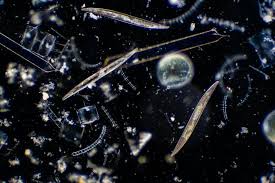Wednesday, December 29, 2021
The Ocean's Other Problem: Deoxygenation
The causes for the fish die-offs were multiple. In the Pacific Northwest, the precipitating
factor was a mammoth heat wave in June that left almost a thousand humans dead,
and billions of fish and bivalves. Fish in coastal waters, especially bays and
inlets, were most affected, as were bivalves living in tidal pools, especially
those lacking northern exposure. These same
areas are those most affected by nutrient run-off, which is a global problem in
highly populated river estuaries. Unless
we move very quickly and decisively to contain contamination of waterways by
agricultural fertilizers, the problem of eutrophication, leading to dead zones
such as the 500-mile one in the Gulf of Mexico at the Mississippi Delta, will
only worsen. Nothing but algae and
jellyfish can live in these conditions.
In Tampa, an unusually bad red tide caused greater than
annual fish die-off. Chinook salmon were
killed in rivers in Washington and at the base of the Shasta Dam in
California. The problems came chiefly
from increasingly lower flows due to drought, exacerbated by extreme heat. In Washington, a lingering columnaris bacteria
infestation of chinook was also worsened by the heat.
But underlying the heat waves and drought experience on land
is a greater problem: ocean deoxygenation.
We have long heard about ocean acidification, which especially affects shell
formation, requiring a very specific ph range that favors calcification. But research
into deoxygenation has lagged until recent years. It is even more threatening to almost all forms of ocean
life. All animals require oxygen, which
is primarily dependent upon photosynthesis.
We are taught from elementary school that this crucial process happens
in trees and other land plants. It is
startling to learn that the majority of oxygen produced on Earth - 50-85% - comes
from phytoplankton, photosynthesizing on or near the surface of the ocean. Since 1950, Earth’s oceans have lost 2% of
their oxygen, with another 3-4% projected loss by 2100. In some tropical areas, as much as 40% of
oxygen has been lost. (Compare average
heat gain to heat gains in the poles, though the observed loss of oxygenation is
greater by a scale of 10).
Like average figures for planetary warming of 1, 2, and 3
degrees Celsius, 2% may not sound like much.
But marine scientists have found that base-of-chain species like phytoplankton
and zooplankton are very sensitive to very small changes in available oxygen. For instance, they may need to go deeper to
breathe, where they are unable to reproduce.
Lack of oxygen degrades sight in a wide array of species (including
humans), so they are more vulnerable to predators. Two key species of zooplankton have already
gone extinct, as I reported five years ago.
The reasons for loss of oceanic oxygen are twofold. First,
warmer water simply holds less gas. Secondly, polar ice melt produces a layer
of less dense, warmer water that forms a kind of lid over colder, more saline
water at greater depths. We think of ocean currents as traveling horizontally at
or near the surface, like the Gulf Stream.
But there is a crucial vertical pump that also operates, which brings
nutrient-rich water from deeper waters to the surface, sending oxygenated
waters down. This vertical mixing has been
slowed by glacial melt, and it is obviously getting worse. One consequence is that marine species migrate
towards higher O2 concentrations, which means more in the top ocean layer. This makes them more susceptible to predators
(including fishermen), and drives some of the colder-loving species to outright
extinction. See these two key articles:
We are already in the Sixth Extinction. When I think of this sad dilemma, my thoughts turn to big cats, rhinos, elephants, and many species of birds. In recent years, we have learned of a frightening increase of insect die-offs, which are of course the greatest number of species at the multicellular level. The oceans don’t have many insects. In fact, they host only around 15% of all species. But they also are habitat for 50-80% of all life on the planet (compare this range with the source of oxygen generation). If slight changes in O2 content can cause extinctions at the base of the food chain, then marine life in general is threatened. The ocean is where life began. It is our mother and remains our container. We may be King of the Mountain, but the mountain, like Turtle Island, is dwarfed by the sea around it. If phytoplankton numbers drop below a critical threshold, we are all doomed, like the fish around the bays this summer panting out their last breaths. If the oceans die, we die.
Subscribe to Comments [Atom]


